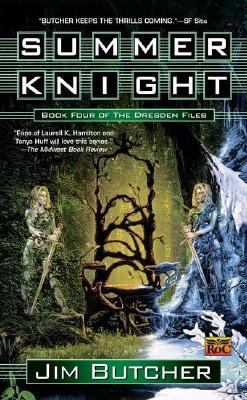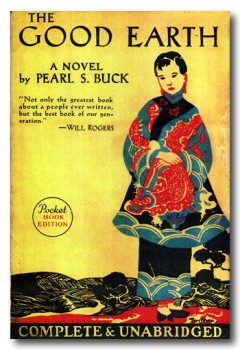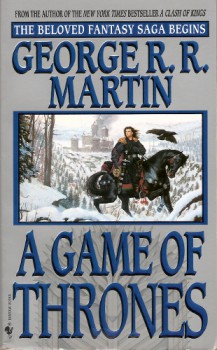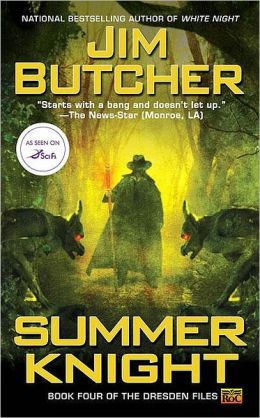Adventures in Bookselling: The Paperback Harry Dresden

Paperback collecting is an odd hobby. For one thing, unlike stamps or coins, virtually no paperback is out of reach for the determined collector.
Want examples? As I mentioned in Jack Vance’s obituary last week, the first edition of The Dying Earth is one of the rarest and most sought-after genre paperbacks — it had a tiny print run, and no one knew who Jack Vance was when it first appeared in 1950.
What does that mean to your pocketbook? I paid just under $20 for a copy in mint condition a few years ago. As of today, around half a dozen are available at Amazon.com, with Very Good copies starting at $10.
Think about that. A first edition of one of the rarest science fiction books, by one of the top authors in the field, a full six decades after it went out of print, will set you back… around the same price as a brand new paperback today.
Perhaps that’s just our genre, you think. Let’s face it, half of the folks who read science fiction and fantasy are anal-retentive fanboys. Probably 50% of the print run of The Dying Earth ended up in protective mylar bags by 1955.
Maybe that’s an exaggeration. Still, the situation for mystery and western fans is pretty much the same. If you’re a paperback collector, it’s a buyer’s market. Walk into the Dealer’s Room at the Windy City Pulp and Paper show (or virtually any paperback show in America) with a crisp $20 bill, and you can walk out with a heavy bag of paperbacks published before you were born.
Hard to believe? Just have a look at the gorgeous assortment of 103 vintage titles I bought for around $50 at Windy City just last year.
Perhaps it’s different if we look outside genre fiction entirely. What’s the rarest and most expensive paperback known?
Well, there are a few answers to that of course, but the one I usually give is Pearl S. Buck’s The Good Earth, sold in a (very) limited edition test run in the then-experimental paperback format in 1938, with a print run of only 2,300. It was a tremendous success and as a result Pocket Books, the country’s first mass market paperback publisher, launched with ten titles in June 1939.

Surviving copies of the unnumbered edition of The Good Earth are exceedingly rare, and it is considered by many the Holy Grail of paperback collecting. Accurately pricing it is very difficult, as copies come to market very rarely, and with books of this value we gauge the actual worth not by what sellers demand, but by actual sale price.
So for something like this we turn to the experts. The most recent edition of Jon Warren’s The Official Price Guide to Paperbacks I have (admittedly, already a little dated) lists Very Good copies of The Good Earth at the lordly price of… (drum roll)… $250.
There you have it. Barring blips in the market for ultra-rare limited printings, one-of-a-kind copies, and the like, high-end paperback collectors can bring home the capstone of the entire industry for around the price of a meal for two at Spago.
This is embarrassing. Really. There are times when I’m ashamed to be a paperback collector. People who collect beer cans are willing to pay more than this. For a can that has no beer in it. (Yes, Mark Rigney, I’m thinking of you).
There are exceptions, of course — especially for things like autographed copies. Science Fiction fans are crazy about autographs, and I’ve seen the price of paperbacks rise considerably when they’re autographed. However, that’s an unpredictable market, and prices can rise and fall as authors rise and fall in collectability. Just ask anyone who paid a premium for a signed Clive Barker limited edition in the mid-1990s, for example.
Admittedly, you don’t see me complaining when I score a collection of 1960s SF paperbacks for less than cover price (especially since the cover price of a 1965 SF novel was around 50 cents…). When it’s a buyer’s market, it’s time to be a buyer. At least until I run out of room in the basement.
But as I said at the top of this article, paperback collecting is an odd hobby. Another of the (many) reasons why is that, while prices for vintage paperbacks have been relatively flat for the past quarter century, that doesn’t mean that interest is low across the board.

In fact, speaking as a paperback buyer and seller, some of the hottest activity in the collectible paperback market in the last decade has been in fantasy series. Just try tracking down a copy of the 1997 Bantam Spectra paperback edition of A Game of Thrones, and you’ll see what I mean.
But in my personal experience, perhaps the most energetic paperback collectors have been Jim Butcher fans. And in particular, fans of his urban fantasy Harry Dresden novels.
The first Dresden novels were released as PBOs (paperback originals) by Roc Books, starting with Storm Front in April, 2000. The next six were PBOs as well; the series didn’t shift to hardcover until the seventh volume, Dead Beat, in 2005. That was also the first to have a cover by Chris McGrath; the earlier paperbacks were eventually re-released with Chris McGrath covers.
I think the McGrath covers are superior; Roc Books (and his fans) seem to agree. Paperback collectors, however, seem to have become obsessed with the earlier editions.
I first noticed this when I tried to replace my own copies about six years ago. At one time I had a complete set, but the Dresden books were among the most in-demand books among our reviewers (not to mention friends and distant family members, all of whom were begging for copies), and my copies were long gone. I tried to find the original Roc paperbacks, but they were impossible to locate.
I remember talking about this phenomenon with fellow readers and collectors at the World Fantasy Convention in Columbus in 2010. I was manning our booth in the Dealer’s Room, selling Black Gate back issues and vintage paperbacks, and sadly turning people away who were asking for Jim Butcher paperbacks. Several friends asked me to keep my eye out for early copies, and some fellow collectors offered very attractive trades for same.
Part of the reason I remember this so well is that on the third day of the convention a determined collector stood up in front of the booth. He’d been digging through the dollar bin on the floor, where I tossed books that had been unsold for years. He was clearly excited, and when he handed his find to me I could see why.

It was an unread, mint-condition copy of Summer Knight, the fourth Dresden novel, with Lee MacLeod’s original cover, out of print for nearly a decade. I must have received a duplicate copy from the publisher in 2002, and placed it in the bin years ago. It had been sitting there, undiscovered, for all this time.
This was a treasure. It would make a lot of collectors very happy — or one of the many friends who had been pestering me for a copy.
Or I could sell it online — just to give you an idea, the lowest current price for an unread copy of the 2002 printing of Summer Knight I found online is $85.26 at Amazon.com.
Of course, you already know I didn’t do any of those things.
What I did was hold out my hand to that excited fan and say, “One dollar, please.”
I told the story to a few friends who dropped by the booth later that day. To their credit, not one of them told me I did the wrong thing. To a one, they all nodded and said, “Yeah, you had to sell it to him.”
Why?
Because we’re all book collectors first. We’ve all spent time digging through boxes of books, and made incredible finds of our own. And that’s just not something you cheat a fellow collector out of.
Besides, I think the truth is that booksellers just want to be part of a joyous find. Whether as a buyer or as a seller, it doesn’t really matter. We get pleasure either way.
But all the same, I keep a closer eye on my dollar bin these days.
Holy crap — $10 for 1st ed Dying Earth? Ordered!!! And I’ll have to go see what my Dresdens look like …
Paperbacks are funny. I bought a large box of vintage westerns a few months back. Paid $50 for the box. I listed four of the title on eBay (thanks to the advice of the estimable John Hocking) and got $46 for them. A few weeks later, I sold all the Gold Medal titles (except for the ones I sent free to Mr. Hocking as a thank-you) for another $12, thus making my money back. But I’ve listed two more batches of these books and got no bites at all. So, now I’ve got 125+ more western paperbacks, virtually none of which I want to read, and no real interest in taking the time to sell. But my goodness are those forties and fifties covers amazing…
I remember about 10 years ago visiting my favorite used book store and finding a bunch of the old Conan paperbacks (with the fill-in material by DeCamp, Carter, etc. before Wandering Star and Del rey did their nice and pure editions) for $20. Strangely enough, they were all published by Ace even though I usually hear of these as being published by Lancer. They were good reading copies, not as fragile as paperbacks that old usually are. I own a few books that I’m afraid to read because they are so old, rare, and fragile.
The final volume of Daniel Abraham’s Long Price Quartet is strangely expensive for a mass market paperback. My wild speculation is that, after years of the chief buyer at B&N refusing to stock the series in stores, B&N was finally willing to stock it, but only in some different format. I don’t really know how to account for what I’ve observed. In any case, now the series is out again in trade paperback, with the first two books in one volume and the third and fourth books in a second volume. I’d love to complete my set of mass market paperbacks so that they all match, but I’m seeing copies of that last volume for $150. Um, well, starting over with trade paperbacks doesn’t look so nutty, now that I’ve priced what I really wanted online.
Hi John,
Trying out to figure out what predominately drives the paperback market is an art that beyond my limited intellect. Some aspects I understand and some others are completely beyond me. I have my own theories though.
Two of my favorite examples are the KEW Kane books with the Frazetta covers and The Seabury Quinn Jules DeGrandin collections put out by “Popular Library back in the 70s with those bizarre Vincent Difate Covers. None of them bring astronomical prices on-line, but they do hold steady at around $15.00 a piece in nice condition. These have held steady for years.
In both cases I think that it’s a combination of a solid fan base and scarcity. And in the case of the Kane series the iconic Frazetta covers don’t hurt either. I honestly think that these are books that are both collected and read for enjoyment. And since readability is a major factor here, I feel that mass reprints would probably knock the bottom out of their current prices. I have the impression that this is what happened to Robert E. Howard paperbacks after those huge DelRey collections came out. Aside from those amazing Berkley collections with the Ken Kelly covers and fold out posters you can get your REH collecting fix at fairly affordable prices.
I don’t want to denigrate either the “Dresden files” or the “Game of Thrones” series, but I have to ask myself is these aren’t simply the current “hot” properties. I personally doubt that these editions will be so “hot” in ten years of so. I could be wrong though, but I think that “attractiveness” plays a substantial though not leading role as far the collectability of SF, Fantasy and Horror is concerned. These series don’t have any “history” behind them yet either. And the “WOW! I have to have that book!” factor, as far my 51 year old viewpoint is concerned, is missing.
Of course your age has a huge affect on what you collect if you just aren’t in it for the money. Like the saying goes; “The golden Age is twelve”. My 12 is 1973 were as another’s 12 is 1983.
Now as far as deep pockets are concerned, Sleaze and sleazy noir crime paperbacks from the 40s and 50s seem to be where the real money is being spent. This time the general popularity doesn’t seem to be based on any particular author fan base or even readability. I have the feeling the “sleazy” and suggestive cover art and the window into a specific place and time in pop culture plays the major role here. If you ever see them, they are so abashedly anti-PC that they come across as ironic satire .But then again, I could be completely wrong. It still seems that the “trash/Fake Porn” factor is the main appeal to collecting this/these genre(s).
And lastly never forget that it seems that what the seller is asking and what the bidders/buyers are willing to pay can be two entirely different animals. The Internet is both a curse and a blessing.
That seller with that one book can now reach hundreds of targeted potential buyers instead of the one person who coincidently wanders into the store and might buy that book. This drives up the prices. On the other hand that seller isn’t the only person selling that one book now. So he has some competition and this drives the price back down. It’s a nice regulating affect. A perfect example is a pristine copy of Harlan Ellison’s “Rock-a-Billy” (“Spider Kiss”) that I found at a flea market over here (Nuremberg Germany) in 1996. It was the Fawcett gold Medal 1st edition! It was mint/cherry/perfect!!! Anyways, this was back when you were still paying per minute on-line time for the Internet. I managed to find a Lawyer in San Francisco who was looking for a copy. After a few emails and a little bit of haggling we settled on $100.00 including postage. I almost wet my pants. Back then I was the only guy in town with a copy that nice. Take a look now and you won’t get a fraction of that amount since we are all interconnected now.
I love this subject and could go on for hours/pages, but I’ll shut up now since I’ve rambled on enough as it is.
http://uncledougsbunkerofhorror.blogspot.de/
> Holy crap — $10 for 1st ed Dying Earth? Ordered!!!
Joe,
Glad you were able to nab it. And thanks to you, the price for a Very Good copy of The Dying Earth at Amazon.com has now shot up to $48.19. Way to mess up my article. 🙂
> And I’ll have to go see what my Dresdens look like …
Careful! You’re starting to talk like a collector.
> now I’ve got 125+ more western paperbacks, virtually none of which I want to read, and no real interest in taking the time to sell.
Mark,
Sounds like you were able to make out okay from that purchase. But I think this illustrates another example of the most imporant maxim in collecting: collect what you love.
I’ve been in exactly your situation many times. Fortunately, the difference is I’m left with a box of science fiction and fantasy books I’m delighted to have. In my experience that’s usually what it comes down to. If you love the hobby, you usually end up on top.
> But my goodness are those forties and fifties covers amazing…
Aren’t they though? I’ve heard it said that paperback collecting isn’t really paperback collecting… it’s paperback COVER collecting. They rest of the book is just backing.
I wouldn’t go that far, but I understand the sentiment. 🙂
Oh — and congratulations on that impressive beer can collection!
> a bunch of the old Conan paperbacks… Strangely enough, they were all published by Ace even though
> I usually hear of these as being published by Lancer.
Amy,
Nice find! The Ace Robert E. Howard is still highly valued by collectors (well, by me anyway.) I think I have most of them on the left in this REH pic I snapped for a PEOPLE OF THE BLACK CIRCLE article last month:
http://www.blackgate.com/wp-content/uploads/2013/04/Robert-E-Howard-book-collection-2013.jpg
My personal favorites are the non-Conan Aces, like PIGEONS FROM HELL, WORMS OF THE EARTH, and especially THE SHE DEVIL. Talk about great covers!
Amy,
I bought all of those Conan books new in the Ace editions back in the 1980’s. When I had to replace them (stupid flood!), I did end up with a mix of Ace and Lancer editions. Unfortunately, it seems like Lancer used particularly shoddy glue back in the day — I have many Lancer books (Conan and others) with loose pages.
> The final volume of Daniel Abraham’s Long Price Quartet is strangely expensive for a mass market paperback.
Sarah,
Huh. You’re absolutely right. Now that you mention it, I don’t think I ever saw a copy of the final book, THE PRICE OF SPRING, in paperback. Amazon seems to think it doesn’t exist, and there’s only a single copy available on eBay, in “Acceptable” condition, for $55.98.
Considering that I found multiplle copies of the 63-year old Hillman edition of THE DYING EARTH on eBay yesterday, that’s a fascinating statistic.
Your theory sounds plausible to me. This must drive poor Daniel Abraham crazy. Glad to see Tor has released them in affordable two-volume omnibus editions.
Speaking of which, I note that the first one – SHADOW AND BETRAYAL – is available for just $7.20:
http://www.amazon.com/Shadow-Betrayal-Long-Price-Quartet/dp/B00B2RQPNG/
So what you are saying is that I should go through and sell all my Dresden File books and replace them with digital ones?
> Two of my favorite examples are the KEW Kane books with the Frazetta covers and The Seabury Quinn Jules DeGrandin
> collections put out by “Popular Library back in the 70s with those bizarre Vincent Difate Covers.
Doug,
You picked some fine examples. The Kane volumes are still highly sought today, and usually command high prices. Like you, I thought the Night Shade omnibus reprints would take the thunder out of that market, but that doesn’t seem to have happened (instead, the two Night Shade books have become hot collectibles on their own!)
I saw you commented on Josh Reynolds’ Seabury Quinn Jules DeGrandin article on Saturday. Glad you enjoyed it!
> Now as far as deep pockets are concerned, Sleaze and sleazy noir crime paperbacks from the 40s and 50s seem
> to be where the real money is being spent. This time the general popularity doesn’t seem to be based on any
> particular author fan base or even readability. I have the feeling the “sleazy” and suggestive cover art and
> the window into a specific place and time in pop culture plays the major role here.
You’re right on target here… just do an eBay book search on “sleaze,” and you’ll see some astounding prices. There don’t seem to be any authors in particular that are collected – it’s all a function of cover art.
> So what you are saying is that I should go through and sell all my Dresden File books and replace them with digital ones?
JLB,
Boy, that’s a topic that deserves its own separate post (or three).
I don’t think there’s any argument that the future of books is digital. All three of my kids enjoy reading on our Kindle and Nook readers (and my daughter reads almost exclusively on hers – she’s impatient if she has to wait more than a few hours for a book!)
But does that mean that paperback collecting is effectively dead?
The market is currently very depressed — the result of both the rise of digital readers, and a host of out-of-business bookstores flooding the online market with stock.
But will it still be depresssed in 5 years? In 50?
I have no idea. I think on some level all collectors are hoarders, packing their homes with the things they love, convinced that someday the world will come to appreciate them the way they do.
All I know for sure is that have a house full of paperbacks, and the chances that they will someday be valued the same way that I value them are pretty darn slim. There’s every chance that by the time I die, my grandchildren will be helping my kids take thousands of books to the recycling drop-off.
But I don’t think so. I think print books will always be valued, and vintage SF and fantasy will always have a market. Maybe I’m kidding myself, but there it is.
As for advice on your books, you’re on your own. I don’t want to be blamed for more than one book hoard, thank you very much.
Had to post this somewhere!
I was at Origins game convention here in Columbus, OH and found a very good copy of Dragon Magazine #2 for just $10!! I snatched it up! I love finding a vintage deal!
James,
Ah! I’m terribly jealous. That’s a great find!
[…] accidently ended up in a dollar bin at my booth at the 2010 World Fantasy Convention, where it was found by a lucky fan). I bought a complete set of the hardcover omnibus editions from the Science Fiction Book Club […]
[…] written here a few times about my adventures as a bookseller. Like that time a buyer found a rare Harry Dresden first edition in our $1 box at the 2010 World Fantasy […]